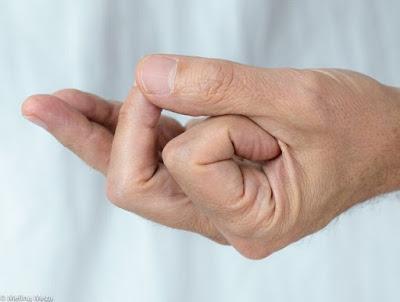
Bhramara Mudra by Melina Meza
Late last year, my colleague Mary Northey gave me wonderful book on yogic hand gestures (hasta mudras) written by Joseph and Lilian LePage. As I first flipped through the pages, my curiosity was piqued. This book alone describes 108 hand mudras (there are other categories of mudra we won’t get into here, such as facial gestures, whole body gestures and others), and there are likely many more hand mudras out there. This was actually not my first exposure to the idea of the uses and potentials of specific hand gestures. Some years ago, I had attended a workshop with Richard Miller, PhD, in which we learned the famous Indian chant and prayer the Gayatri mantra, and the extensive series of hand mudras that are sometimes performed while chanting the mantra. And many of my teachers over the years used the most commonly done mudras at end of class or during a final sitting meditation, such as Anjali mudra (prayer position) or Jnana mudra (wisdom mudra). I also remember seeing hand mudras as part of an Indian classical dance performance on my trip to India in 2005, an art they have long been associated with. We even have had an excellent post on our blog by Beth Gibbs on mudra Mudras for Healthy Aging.So, as I started to regularly include mudra into my morning meditation practices in November and December of 2015, I very quickly discovered to my delight that my mind was more focused during meditation than it had been prior to introducing mudras. Regardless of the many other benefits that modern practitioners attribute to mudra, I was more than satisfied with this tangible initial benefit. With that personal discovery, I decided to share a new mudra each week with my local yoga classes as part of the initial meditation we do at the start of each class. We are now 9+ months into it, and my students love it! Many have reported back finding the mudra added to their home meditation and breath practices helpful in calming, energizing, and balancing their minds and bodies.
What I myself have delighted in discovering in my 10 months of mudra exploration is how many of the mudra have potential benefits for physical and mental-emotional wellbeing. There are mudras to address headaches, pain, anxiety, depression, stress, the health of the lungs and heart, and really almost every system of the body. The present challenge with all these “potential” health benefits is that to date we have no scientific studies looking at the outcomes of doing mudra regularly, nor how they might work. However, they are incredibly safe to practice and almost anyone can do the hand gestures, even if they cannot do full asana practice, as another way of experiencing yoga. And Joseph LePage suggests that they can also increase hand strength and finger dexterity as a beneficial side effect. As I observe my own mom’s gradual diminished abilities with hand dexterity, I am hopeful that including them in my practice can be both preventative now, and a form of treatment down the road if needed for my hands!
To recap, my discussion highlights the following upsides to learning and using mudras: they can deepen your concentration and focus in meditation and pranayama, they could potentially have a positive impact a wide variety of health conditions, and they have beneficial effects for your hands.
One of my favorite mudras is Bhramara mudra, which is named after the bumblebee, and is related to the same word as the breath technique Bhramari (Buzzing Bee) Breath. I like this one because the position of the fingers and hands is just challenging enough to maintain that it works well of keep my focus on the here and now. (And it’s said to be useful for allergies and to help bolster your immune system, which would be great benefits for fall.)
You can do Bhramara mudra in any seated, reclined, or even standing position, and can combine it with any meditation and pranayama techniques.
To practice the Bhramara mudra:
- With your palm facing up, curl the tip of your index finger to the base of your thumb, where your thumb meets your palm.
- Touch your thumb pad to the edge of the last digit of your middle finger.
- Extend your 4th and 5th fingers, as shown in the photo.
- If you are sitting in a meditation position, place the back of your hands on your legs. Maintain a lifted spine, relax your shoulders, and let your arms be slightly away from sides of your torso.
- Because this mudra can be a bit challenging to hold, start by holding the mudra for 2-5 minutes and gradually work up to longer holds of up to 45 minutes. You can repeat up to three times a day (but probably not for more than a total of 45 minutes/day).
- When you are done, shake out your hands and wrists, and wiggle your fingers.
Subscribe to Yoga for Healthy Aging by Email ° Follow Yoga for Healthy Aging on Facebook ° Join this site with Google Friend Connect

